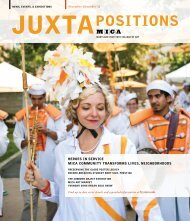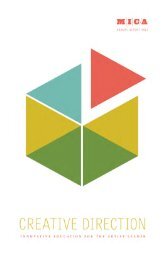art/vision/voice - Maryland Institute College of Art
art/vision/voice - Maryland Institute College of Art
art/vision/voice - Maryland Institute College of Art
Create successful ePaper yourself
Turn your PDF publications into a flip-book with our unique Google optimized e-Paper software.
20 <strong>art</strong> / <strong>vision</strong> / <strong>voice</strong><br />
working together on a mini wall mural.<br />
At this time, Banner Neighborhoods convened a community conference<br />
which revealed that while the adults had justifiable concerns, the youth<br />
had a legitimate complaint that also needed to be addressed: there was<br />
no safe place to play, and Patterson Park was still a dangerous place for<br />
younger children. Banner helped to mediate a heated dialogue, and the<br />
outcome was that several adult community members and Banner staff<br />
pledged unwavering support for providing safe, adult-supervised activities<br />
for youth through a range <strong>of</strong> programs. The group’s first effort, the<br />
Banner Football League, was a resounding success. In addition to this<br />
highly successful sports program, new <strong>art</strong>s programming was piloted. Local<br />
community <strong>art</strong>ist Cinder Hypki worked with neighborhood children to<br />
create an outdoor mosaic gallery in a garden at the he<strong>art</strong> <strong>of</strong> the community.<br />
When Cinder later joined the cap staff, mica took advantage <strong>of</strong><br />
her spadework in the community. With funding from the Baltimore<br />
Community Foundation’s A-Teams Initiative, cap and Banner agreed<br />
to create the Banner <strong>Art</strong> Club in Patterson Place. This after-school <strong>art</strong>s<br />
program provided a group <strong>of</strong> fifteen eleven- to fourteen-year-olds with<br />
<strong>art</strong>s-related learning experiences twice-weekly for ten weeks during<br />
the winter <strong>of</strong> 2003. The youth Banner recruited for the <strong>Art</strong> Club reflected<br />
the demographic <strong>of</strong> the neighborhoods: most were African American;<br />
one white and one Hispanic family were represented. Most <strong>of</strong> the children<br />
came from economically disadvantaged homes that varied widely in<br />
terms <strong>of</strong> parental involvement in their children’s activities.<br />
The cap team that arrived on the scene was diverse in its own way.<br />
Five <strong>of</strong> the seven, including all three leaders, were white. One student<br />
was African American, and the other was Chinese American. All but one<br />
were female. Two <strong>of</strong> the three leaders were graduate students; all other<br />
team members were undergraduates. Not one member <strong>of</strong> the team was<br />
from Baltimore.<br />
Since Banner had not completed the necessary renovations for a<br />
planned community <strong>art</strong> studio in a building near its <strong>of</strong>fices, the pastor<br />
<strong>of</strong> nearby St. Elizabeth’s Church, located adjacent to Patterson Park,<br />
volunteered the church hall as the site for the <strong>art</strong> club.
















